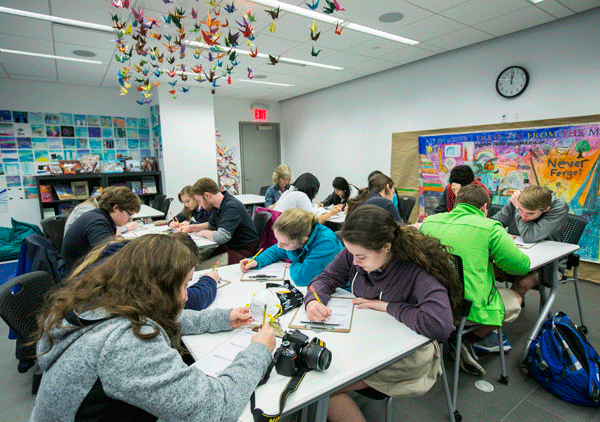
Students participating in a workshop at the 9/11 Museum.
BY DUSICA SUE MALESEVIC | “The kids were blown away.”
That is how Robert Sandler, a teacher at Stuyvesant High School, described his class’ recent visit to the 9/11 Museum. Sandler teaches a senior elective New York City History and took his class to the museum for the first time.
“I thought it was incredibly powerful,” said Sandler, who also teaches an advanced placement U.S. history course, in a phone interview. He was at Stuyvesant when the Sept. 11 attacks happened and he remembers the F.B.I. being in the lobby, gas masks, kids screaming and the evacuation.
First, the students went to the reflecting pools of the memorial and then to the museum where they saw artifacts from the day of the attacks. The students also listened to audio of people calling their families before the tower collapsed.
Afterwards, he asked students to write evaluations and many said it was the most powerful educational experience of their life.
But how many students are having this experience — specifically those who attend schools near where the tragic events took place? It seems to be a mixed bag when it comes to Lower Manhattan public schools visiting the museum — for a variety of reasons. One educator said that no museum is part of the curriculum. Another said that there is too much material to cover to even get to 9/11 whereas for others it comes at the end of the year.
More than 17,000 New York City students have gone to the museum since it opened last May, Anthony Guido, director of communications for the 9/11 Memorial and Museum, wrote in an email.
There are 1.1 million students in New York City, so less than two percent have visited.
In September last year, the museum started classrooms workshops and 181 classes have gone, said Guido. This number reflects how many classes have taken the workshops until the end of this March.
Out of those 181, which he said is around 4,000 students, 40 classes were from Manhattan, but he had no further breakdown of the numbers by neighborhoods and there is no way to tell how many were from Lower Manhattan. Out of those students, 1,800 were high schoolers and 1,100 were middle schoolers.
At the High School of Economics and Finance at 100 Trinity Place, Raj Nanda, an assistant principal, said that it has a ninth grade bridge program that offers students entering the high school to attend a month-long summer session that includes a visit to the museum.
Nanda also teaches U.S. history for 11th graders and said that since 9/11 comes at the end of the school year in the curriculum, it doesn’t make sense time wise to go to the museum. However, Nanda said in a phone interview that he strongly encourages students to visit to the museum since it is so close.
No classes from Millennium High School at 75 Broad St. have gone as a group to the museum, said Angela Benfield, parent coordinator, in an email.
Individual students have visited and a few have participated in a museum community service project, but no classes, she said. Millennium High School was founded in 2002 with 9/11 recovery money as a way to help revitalize Lower Manhattan and its mascot is the Phoenix, the mythical bird that rises from the ashes.
Initially, Benfield cited price as a deterrent — it costs $24 for an adult and $15 for those seven to 17.
The museum is free — both the admission and the workshops — for New York State schools, kindergarten through 12th grade. Benfield did not know admission was free and later said she would talk to the principal and teachers about organizing a trip.
The museum said that there has been outreach through the city’s Department of Education and their website, and the focus has been on creating a presence throughout all five boroughs and beyond the city. There are plans to reach out to Lower Manhattan schools specifically next year.
“Providing a place to educate the students of today, as well as future generations, is both a fundamental and critical aspect of our mission,” Joe Daniels, president of the 9/11 Memorial and Museum, said in a statement to Downtown Express. “Our classroom workshops are designed to challenge students to think critically about a wide range of topics related to 9/11.”
Principal Terri Ruyter of P.S./I.S. 276 in Battery Park City, said that as middle school curriculum has so many topics to cover, no classes have been to the museum.
“We barely get to Vietnam,” she said in an email.
Correction: In the original version, Robert Sandler’s last name was misspelled.

















